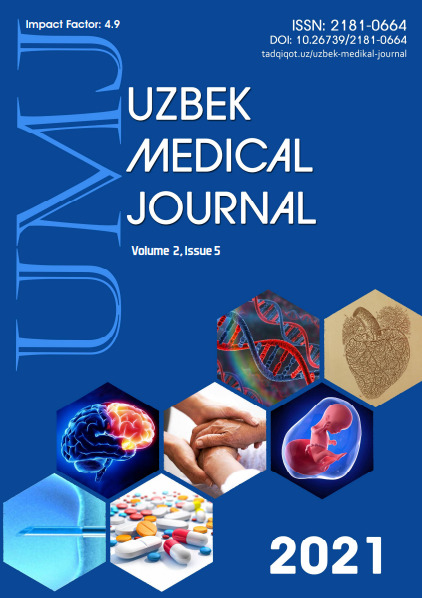КЛИНИЧЕСКОЕ ТЕЧЕНИЕ ПЕРИМЕНОПАУЗАЛЬНОГО ПЕРИОДА У ЖЕНЩИН С СИНДРОМОМ ГИПЕРАНДРОГЕНИИ
Ключевые слова:
гиперандрогения, гормоны, яичники, надпочечники, репродуктивные нарушенияАннотация
Гиперандрогения – расстройство эндокринного статуса, обусловленное избыточной продукцией андрогенов. Данный синдром является следствием повышенной продукции андрогенов как в яичниках, так и в надпочечниках. Однако такое разделение носит весьма условный характер, так как повышенная продукция андрогенов в надпочечниках может приводить к их повышенной продукции в яичниках и наоборот. Андрогены у женщин синтезируются яичниками, надпочечниками и периферическими тканями, которые также принимают активное участие в метаболизме. Набор андрогенов и у женщин, и у мужчин включает дегидроэпиандростерон-сульфат, дегидроэпиандростерон, андростендион, тестостерон и 5-альфа-дигидротестостерон (5-альфа-ДГТ), но в отличие от мужчин у женщин концентрация первых трех гормонов выше, чем двух последних. Синтез андрогенов в надпочечниках у женщин регулируется адренокортикотропным, а в яичниках – лютеинизирующим гормоном (ЛГ), а также некоторыми другими интрагландулярными аутопаракринными механизмами. Благодаря последним исследованиям помимо основных биологических, ранее общеизвестных эффектов андрогенов были открыты их новые механизмы влияния на организм женщины.
Библиографические ссылки
Brown D.L., Henrichsen T.L., Clayton A.C., Hudson S.B., Coddngton C.C., Vella A. Ovarian stromal hyperthecosis: sonographic features and histologic associations. J Ultrasound Med 2009; 28: 587—593.
Buggs C., Rosenfield R.L. Polycystic ovary syndrome in adolescence. Endocrinol Metabol Clin North Am 2005; 34: 677—705.
Cordera F., Grant C., van Heerden J., Thompson G., Young W. Androgensecreting adrenal tumors. Surgery 2003; 134: 874—880.
Davison S.L., Bell R., Donath S., Montalto J.G., Davis S.R. Androgen levels in adult females: changes with age, menopause, and oophorectomy. J Clin Endocrinol Metabol 2005; 90: 3847—3853.
Diamanti-Kandarakis E., Lambrinoudaki I., Economou F. Androgens associated with advanced glycation end-products in postmenopausal women. Menopause 2010; 17: 1182—1187.
Dorgan J.F., Stanczyk F.Z., Kahle L.L., Brinton L.A. Prospective case-control study of premenopausal serum estradiol and testosterone levels and breast cancer risk. Breast Cancer Res 2011; 12: R98.
Kaltsas G.A., Isidori A.M., Kola B.P. The value of the low-dosedexamethasone suppression test in the differential diagnosis of hyperandrogenism in women. J Clin Endocrinol Metabol 2003; 88: 2634—2643.
Klotz R.K., Muller-Holzner E., Fessler S. Leydig-celltumor of the ovary that responded to GnRH-analogue administration — case report and literature review. Exp Clin Endocrinol Diabetol 2010; 118: 291—297.
Krug E., Berga S.L. Postmenopausal hyperthecosis: functional dysregulation of androgenesis in the climacteric ovary. Obstet Gynecol 2002; 99: 893—897.
Martin K.A., Chang R.J., Ehrmann D.A., Ibanez L., Lobo R.A., Rosenfield R.L., Shapiro J., Montori V.N., Swiglo B.A. Evaluation and treatment of hirsutism in premenopausal women: an Endocrine Society Clinical Practice Guideline. J Clin Endocrinol Metabol 2008; 93: 1105—1120.
Nieman L.K. Approach to the patient with an adrenal incidentaloma. J Clin Endocrinol Metabol 2010; 95: 4106—4113. 15. Norman R.J.D., Legro R.S., Hickey T.E. Polycystic ovary syndrome. Lancet 2007; 370: 685—697.
Rittmaster R.S. Polycystic ovary syndrome, hyperthecosis and the menopause. Clin Endocrinol (Oxford) 1997; 46: 129—130.
Rosner W., Auchus R.J., Azziz R., Sluss P.M., Raff H. Position statement: utility, limitations, and pitfalls in measuring testosterone: an Endocrine Society position statement. J Clin Endocrinol Metabol 2007; 92: 405—413.
Rothman M.S., Carlson N.E., Xu M. Reexamination of testosterone, dihydrotestosterone, estradiol and estrone levels across the menstrual cycle and in postmenopausal women measured by liquid chromatography-tandem mass spectrometry. Steroids 2011; 76: 177—182.
Rothman M.S., Wierman M.E. How should postmenopausal androgen excess be evaluated? Clin Endocrinol 2011; 75: 160—164.
Rotterdam ESHRE/ASRM-Sponsored PCOS consensus workshop group. Revised 2003 consensus on diagnostic criteria and long-term health risks related to polycystic ovary syndrome (PCOS). Hum Reprod 2004; 19: 41—47.
Shaw L.J., Bairey Merz C.N., Azziz R., Stanczyk F.Z., Sopko G., Braunstein G.D., Kelsey S.F., Kip K.E., Cooper-Dehoff R.H., Johnson B.D., Vaccarino V., Reis S.E. Postmenopausal women with a history of irregular menses and elevated androgen measurements at high risk for worsening cardiovascular event-free survival: results from the National Institutes of Health — National Heart, Lung, and Blood Institute sponsored Women’s Ischemia Syndrome Evaluation. J Clin Endocrinol Metabol 2008; 93: 1276—1284.
Speiser P.W., Azziz R., Baskin L.S., Ghizzoni L., Hensle T.W., Merke D.B. Congenital adrenal hyperplasia due to steroid 21-hydroxylase deficiency: an Endocrine Society clinical practice guideline. J Clin Endocrinol Metabol 2010; 95: 4133—4160.
Thompson G.B., Young W.F.Jr. Adrenal incidentaloma. Curr Opin Oncol 2003; 15: 84—90.
Waggoner W., Boots L.R., Azziz R. Total testosterone and DHEAS levels as predictors of androgen-secreting neoplasms: a populational study. Gynecol Endocrinol 1999; 13: 394—400.
Wild R.A., Carmina E., Diamanti-Kandarakis E., Dokras A., Escobar-Morreale H.F., Futterweit W., Lobo R., Norman R.J., Taibott E., Dumesic D.A. Assessment of cardiovascular risk and prevention of cardiovascular disease in women with the polycystic ovary syndrome: a consensus statement by the Androgen Excess and Polycystic Ovary Syndrome (AE-PCOS) Society. J Clin Endocrinol Metabol 2010; 95: 2038—2049.
Winters S.J., Talbott E., Guzick D.S., Zborowsky J., McHugh K.P. Serum testosterone levels decrease in middle age in women with the polycystic ovary syndrome. Fertil Steril 2000; 73: 724—729.
Yetkin D.O., Demirsoy E.T., Kadioglu P. Pure leydig cell tumour of the ovary in a post-menopausal patient with severe hyperandrogenism and erythrocytosis. Gynecol Endocrinol 2011; 27: 237—240.

